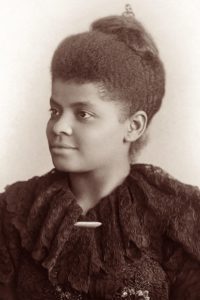Since the early 19th century, African-American publications have built community and challenged injustice.
June 18, 2020
It isn’t enough to have a voice, it must also be used and heard. “Too long have others spoken for us,” announced the first issue of Freedom’s Journal, the first black-owned and operated newspaper in the U.S. Founded by Samuel Cornish and John Russwurm in 1827, the weekly New York City paper published news and opinions; almost equally important, it provided an advertising platform for black businesses, charities and organizations. During its two-year run, Freedom’s Journal reached 50,000 households in 11 states, helping to foster a sense of community and pride among the free but disenfranchised African-Americans of the North.

Journalist Ida B. Wells, ca. 1893.
PHOTO: ALAMY
Black-owned newspapers multiplied in the decades before the Civil War. Some were abolitionist, such as Frederick Douglass’s The North Star, founded in Rochester, N.Y., in 1847. Others were religious: The Christian Recorder, the official periodical of the African Methodist Episcopal Church, was founded in 1848 and is still published today, making it the longest-running African-American periodical.
Black journalists were often targeted for violence by whites. In 1892, the lynching of three black men in Memphis, Tenn., prompted the young Ida B. Wells to begin an anti-lynching crusade in the Memphis Free Speech and Headlight, the newspaper she co-owned and edited. Her courageous reporting brought international attention to the atrocities taking place with impunity in the South. But it also made her a marked woman: The newspaper’s staff was attacked and its office burned down. Wells left Memphis and urged her readers to do the same: “There is, therefore, only one thing left to do; save our money and leave.”
In the early 20th century, the Chicago Defender was one of the most influential papers in the U.S., black or white. Its aggressive championing of what would become known as “The Great Migration” helped persuade many African-Americans to move to Chicago and other Northern cities. Literature and the arts were nourished by The Crisis, the monthly magazine of the NAACP. Founded in 1910 by W.E.B. DuBois, it featured up-and-coming black writers such as Langston Hughes and Countee Cullen.
The influence of black-owned newspapers sometimes incurred the wrath of the U.S. government. During World War II, the Pittsburgh Courier campaigned for equal rights for black soldiers, leading FBI Director J. Edgar Hoover to try to charge its publishers with treason. The effort was thwarted by other members of the Roosevelt administration, and black newspapers continued to play a vital role in the civil-rights movement of the 1950s and 60s.
But barriers remained. In 1968, Coretta Scott King had to demand that the press pool covering her husband’s funeral include a black photographer. Moneta Sleet of Ebony magazine was selected and his photograph of Mrs. King and her daughter went on to win a Pulitzer Prize, making him the first African-American man to receive the award.
The Pulitzer confirmed Ebony’s status as the leading black publication in the U.S. Founded by John H. Johnson in 1945, by the early 2000s it was read by almost 40% of all African-American adults, giving it a clout that corporate America couldn’t afford to ignore.
The black press is continually evolving and expanding, from the women’s magazine Essence, which celebrated its 50th birthday this year, to Blavity, a web magazine for millennials launched in 2014. The current Black Lives Matter protests show just how vital these voices continue to be.





